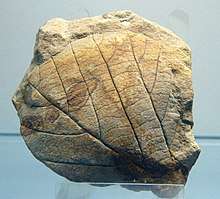Credneria
Credneria (Zenker 1833) is an extinct genus in the family Salicaceae[1] or Platanaceae[2][3] of broad-leaf trees similar to extinct Platanus species that appeared during the Cretaceous. Its foliage is preserved in sandstone and less often in siltstone. The leaves are typically obovate with a pinnate-actinodromous venation and distinct suprabasal veins.[4]

Fossil Credneria triacuminata leaf in the Botanischer Garten Dresden
| Credneria | |
|---|---|
| Scientific classification | |
| Kingdom: | Plantae |
| Clade: | Tracheophytes |
| Clade: | Angiosperms |
| Clade: | Eudicots |
| Clade: | Rosids |
| Order: | Malpighiales |
| Family: | Salicaceae |
| Genus: | †Credneria Zenker |
Species
Known species are:[5][1][6][7]
- Crednetia triacuminata (Hampe),[8] the first broad-leafed tree known
- Crednetia basinervosa (Hollick) [9]
- Crednetia cuneifolia
- Crednetia bohemica
- Crednetia subserrata (Hampe)
- Crednetia denticulata [10]
- Crednetia subtriloba
- Crednetia integerrima
- Crednetia biloba
- Crednetia comparabilis [11]
- Crednetia daturaefolia (Ward) [12]
- Crednetia elegans [13]
- Crednetia grewiopsoides [14]
- Crednetia inordinata
- Crednetia intermedia
- Crednetia longifolia
- Crednetia mixta
- Crednetia pachyphylla
- Crednetia parva
- Crednetia prophylloides (Knowlton)
- Crednetia pulchra
- Crednetia spatiosa
- Crednetia sudanense
gollark: The old slow node version.
gollark: * IDs
gollark: Although older skynets had non-persistent client Ids.
gollark: skynet, for trust reasons, has no authentication mechanism whatsoever.
gollark: Guaranteed ZERO collisions (for string inputs)!
References
- "Credneria Zenker, 1833".
- Thomas Denk & Maria V. Tekleva (2006). "Comparative pollen morphology and ultrastructure of Platanus: Implications for phylogeny and evaluation of the fossil record". Grana. 45:3 (3): 195–221. doi:10.1080/00173130600873901.
- Collinson, Margaret E (1992). "The early fossil history of Salicaceae: a brief review". Proceedings of the Royal Society of Edinburgh. Section B. Biological Sciences. 98: 155–167. doi:10.1017/S0269727000007521.
- Georg F. Tschana; Thomas Denka; Maria von Balthazara (2008). "Credneria and Platanus (Platanaceae) from the Late Cretaceous (Santonian) of Quedlinburg, Germany". Review of Palaeobotany and Palynology. 152 (3–4): 211–236. doi:10.1016/j.revpalbo.2008.05.004.
- Halamski, A.T. (2013). "Latest Cretaceous leaf floras from southern Poland and western Ukraine" (PDF). Acta Palaeontologica Polonica. 58 (2): 407–443.
- P. B. Richter (1905). Über die Kreidepflanzen der Umgebung Quedlinburgs (PDF). Archived from the original (PDF) on 2017-04-25. Retrieved 2017-04-24.
- Knobloch E. (1997). ""Credneria" bohemica Velenovský – eine altertümliche Platane". Palaeontographica B. 1242: 127–148.
- "A fossil leaf of Credneria triacuminata. Large leaves are indicative of humid tropical climates. This specimen is approximately 17cms [sic] wide, it was found in Heidelberg, Germany and dates back to the Late Cretaceous". PortForLio.
- "Credneria basinervosa Hollick".
- "Credneria denticulata".
- "Credneria comparabilis Hollick".
- "Credneria daturaefolia Ward".
- "Credneria elegans Hollick".
- "Credneria grewiopsoides Hollick".
This article is issued from Wikipedia. The text is licensed under Creative Commons - Attribution - Sharealike. Additional terms may apply for the media files.